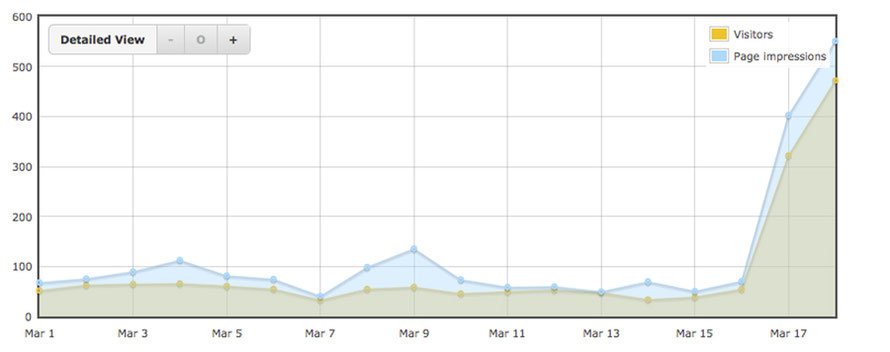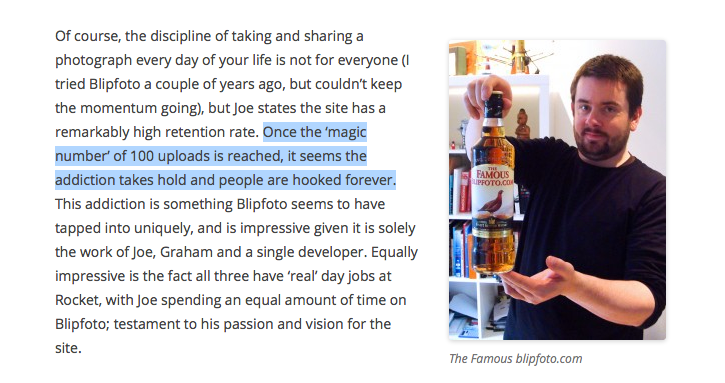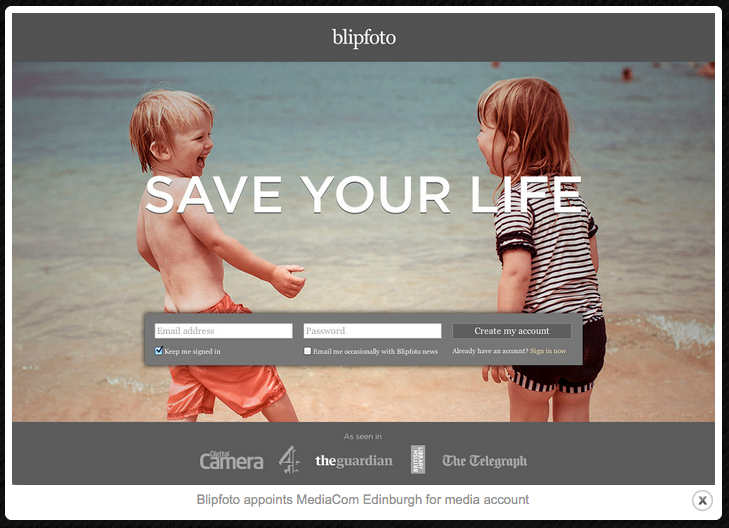Thinking about Blipfoto's future

Update 30/3/15: Since writing this blog entry I've posted a number of others. The last, 'Barking up the wrong tree? A reinterpretation of the Blipfoto/Polaroid tie-up' should be read alongside this one. Thanks.
Introduction
If you are reading this you probably know that Blipfoto Ltd has gone into compulsory liquidation. You probably also know by now that Tom MacLennan of FRP Advisory LLP, the provisional liquidator of Blipfoto Ltd, has selected a preferred bidder for company. If not you might want to read my blog entry of yesterday.
I’ve been thinking about why the owners of the Polaroid brand might want to acquire Blipfoto and I've put together this set of notes. They are very speculative and who is to tell how things will
turn out. I think there is something pretty unique about Blipfoto but whether you can turn that into hard cash is another matter. £900,000 had been invested in the company- apparently nearly half
of that from Scottish Enterprise which is largely funded through the Scottish Government. But I'm staying for now unless I get pushed.
I've been following the exchanges on the Facebook Blipfoto Friends page today on and off. I stand to lose relatively little and I've never had a chance to pay a sub. There was a mix up with my
email address and my messages to Blip Central went unanswered. I've also seen a Tweet from a former employee who says there is no sign of being re-employed. They await on the liquidator for a
settlement.
I'm making this blog public with more trepidation than yesterday's. It can't and doesn't resolve any of the issues that people are agonising about. I've seen one comment to the effect that if 'blippers' make a lot of public - well social media - noise the investors might run off.
I imagine they are made of sterner stuff than that and, as I argue, that they are after something more important than the current users and user community (which raises the question of the identity of that community - is it one or many and its changing/or not demographic and geographical base). But I'll let you be the judge of that.
I was amazed that over 300 people looked at my blog post of yesterday and on the basis of the positive feedback I received I thought I'd try and take the process a bit further.
And to start to do that I needed first to try and understand who the preferred bidders for the liquidised Blipfoto were.

The Hilco Global Press Release
So I went to Hilco Global press release of yesterday night.
The release tells us that a group of investors who are ‘behind several of the Polaroid brand properties’ have been named as preferred bidder. And that the group includes Jeffrey B. Hecktman – CEO of Hilco Global - and Bobby Sager Partner and a Director at Gordon Brothers.
We are told that Mr. Hecktman – the investor, CEO and Chairman of Hilco Global said,
"The Blipfoto brand has created a genuine global community with users in over 175 countries who share the most important moments of their lives on a daily basis. By leveraging this type of powerful social media tool with the direction and great success we are having with the Polaroid brand as a whole and our new retail concept called Polaroid Fotobar, we believe this is as a fantastic addition to our current growth platform.’
We are also told that Scott W. Hardy – President and CEO of Polaroid - has indicated his support for the acquisition and his enthusiasm for a strong and continued brand strategic partnership.
Hardy says,
"We continue to see tremendous value in Polaroid Blipfoto from both a business and a human perspective. This was true in January when we announced our partnership, and continues to be true today. The heartfelt expressions of support and affinity for Polaroid Blipfoto from members of the community this past week are as clear an indication as you can get of just how much this service means to the people who use it. We are delighted to have reached an agreement that will enable us to keep this vibrant and important community alive and well for current and future users."
So who are these people and companies? And why might they be keeping 'this vibrant and important community alive and well for current and future users'?
The preferred bidders and Polaroid
Hilco Global and Gordon Brothers are large American companies that
specialise in sorting out distressed companies, assets and real estate. You should really take a bit of time exploring their websites. The history page on the Hilco Global website is not a bad place to
start.
One of those distressed companies that Hilco Global and Gordon Brothers sorted out was bankrupt Polaroid in 2009.
Indeed, Hilco Global and Gordon Brothers Brands bought the assets of the Polaroid Corporation in 2009 and placed the Polaroid Corporation in joint holding under a parent company named PLR IP
Holdings, LLC. Much later PLR IP acquired over 30% of the share capital of Polaroid Blipfoto (see Wikipedia: Polaroid Corpoartion and my blog of yesterday).
Update: in December 2014 the Minnesota’s Pohlad family acquired majority ownership of Polaroid in a $70
million deal and now control of about 65 percent of the company. This size of this holding is not revealed in the Polaroid press release.
“We are doing this for three reasons,” Jann Ozzello Wilcox, chief investment officer of Pohlad-owned Marquette Companies, said.
“First, we continue to seek good, strategic growth opportunities; second, we see Polaroid as an iconic brand with a licensing model that’s working, and third, it’s a local company with a solid management team,” Wilcox said.
This article also reveals that the Minnetonka HQ of Polaroid only has less than 25 employees.
But the acquisition by the Pohlad family is interesting in as much as it indicates that a major Minnesota investor is confident to sink $70m in Polaroid. In terms of corporate investing its
pretty small stuff and on a proportional basis the deal suggests a Polaroid valuation at about $108m. [Update ends].
So when the CEO of Polaroid says he indicates his support for the acquisition of Blipfoto by the preferred bidders in the March 17 press release above he is doing it from his position in a company owned by the people doing the acquiring.
As far as I can tell Hilco Global and Gordon Brothers still own Polaroid. In a Hilco Brands (a subsidiary of Hilco Global) press release of 2014 the companies welcome the arrival of two new family investment bodies into Polaroid.
The Global Licensing Platform
This release also states that since acquisition in 2009 Hilco and GBB have ‘transformed the company [Polaroid] into a global licensing platform under a new management team'.
A global licensing platform? That is, as I understand it, Polaroid doesn’t make actual things anymore. It is a powerful brand that is licensed out to others to make things under the Polaroid
brand - see here for more on the rise of brand licensing. This shift is explained in this coverage of the Polaroid/Blipfoto collaboration at the
beginning of 2015
Polaroid’s business model has shifted from a vertical operating company to a licensing model that seeks out compatible worldwide partners, including manufacturers, distributors and service providers — for example the company’s branding of the Socialmatic camera and the Cube camcorder. Like those partnerships, Blipfoto and Polaroid consider each other to be perfectly aligned.
So, to recap, the preferred bidder for Polaroid Blipfoto is a group of investors who include the two companies that bought the assets of Polaroid in 2009 rather than Polaroid itself.
Now you wonder why these large companies have shown any interest in Blipfoto.
People in the Blipfoto community might think this is because 'the community' is what makes Blipfoto but I suspect this is not that important to Hilco Global, Gordon Brothers and their jointly
owned Polaroid licensing platform.
The Treasured Moments at the heart of Blipfoto business model
So what is it all about?
I think the secret (if there is one) lies in the phrase spoken by Mr Hecktman of Hilco Global in the press release of 17 March. He
said,
‘The Blipfoto brand has created global community with users in over 175 countries who share the most important moments of their lives on a daily basis.’ (Emphasis added)
And within this I think the most important words are ‘global’, ‘users’ and ‘share the most important moments of their lives on a daily basis’.
If you like, the kernel of the Blipfoto business model is about ‘treasured moments strung together over time.’ The problem is how to monetize those moments if you are not going to rely on user
subscriptions - which clearly didn't work at Blipfoto or Polaroid Blipfoto once its raised its ambitions to a global scale (see The Scotsman article of today).
But why are these daily 'treasured moments' so important? Surely these companies that are used to unsentimental asset disposal and distressed sales worth billions of dollars have not gone soft in the head?
I think they are taking a further punt on Polaroid Blipfoto because of the self-curated nature of Blipfoto with its journal records of treasured moments throughout a year or multiple years. The rubbish and crap photos have already been edited out. What’s left is the gold dust after a long and often intense process of panning/editing by the users.
Polaroid Fotobar
If you think about an operation like photo developing is a pretty mass production, low value added and competitive business. And if you are setting up something like Polaroid Fotobar what you want to do is use it to
maximize the revenue you can get out of licensing and franchising the Polaroid brand. And one way to do that is to maximize your sales of quality prints and a whole plethora of photographic
add-ons from cameras to frames, albums and all sorts.
(Polaroid Fotobar seems to be an online shop and
shop franchise business of photograph accessories, photos, cameras, film, photo home decor and monthly photo deals.)
In the normal run of the mill world people get photos developed – if at all these days - around key events – births, weddings, holidays, school stuff etc. And people chuck in whole rolls of film/USB cards to the developer/printer and most photos are never looked at. And with digital cameras and camera phones the number of images grows and grows.
So the great thing about Blipfoto is that the customer takes photos on a daily basis, pre-selects the good ones and instills them with memory and a narrative on a website journal. It is a way of
producing a constant stream of ‘magic moments’ that are held on the servers of the company. The user community is vital in validating that process and I have found it a genuinely supportive and
moving community to be part of.
Such moments are more valuable than ‘snaps’. So people might be willing to monetise those moments by spending more on printing and presentation. So you buy books of your journal and prints of your photos and all the paraphernalia that goes with that – including something called ‘photo home décor’ on the Polaroid Fotobar website.
But if I were trying to build and maximize the Polaroid brand and the lucrative licensing opportunities that it might afford I don’t think I’d be terribly concerned about the Blipfoto ‘community ‘ (gawd love ‘em) - at least in a commercial sense.

The Uses of the User Community
That might particularly be the case as the demographic of Blipfoto - which I really like - seems a wee bit out of kilter with the ‘young and fun’ appeal/targeting of the Polaroid brand (see the
main website here ). Further, I wonder if blippers are
generally too serious as photographers to be likely to generate sales of Polaroid gear.
But I’d want to keep them for the time being. Just like restaurants like to put people in the window seats. It makes it look inviting and vibrant. But I think I might be going after a different
demographic and a different sort of camera user in the medium term if I were sitting at the middle of the Polaroid licensing platform.
How many people do you need to put front of house to make a social media site look busy and inviting? The Hilco Global 17 March press release says Polaroid Blipfoto hosts more than 5 million images.
That sounds a lot but divide 5 million by the 365 days in a year and you get 13,698 users – and that’s just over one year. I’m not saying that's how many users there are because I don't know. But if there were loads more you'd expect the site to hosting more millions of photos.

(A DC Consulting press release in December 2012 said that Blipfoto 'already has tens of thousands of users globally' which would suggest at
least 20,000 users and that it hosted almost 2.5 million images. At this point almost £700,000 had been invested in Blipfoto to build 'a scalable customer acquisition model and fuel
growth.')
[Update 31 March 2015: I noticed last night that the JT liquidation blip got 14.1k views. Compared to the 5k for the 'good news' blip. I imagine the first got quite a lot of views from of the
website.
If we took 14k as the paid up regular user number (a huge assumption) and multiply by £25pa sub you get a revenue stream of £350,000. I suspect with free life memberships and other things it's
nowhere near that but assuming that it is that would be £29k a month to cover all costs staff, rent, serves, marketing,etc etc. Divide 29k by 11 and multiple by 12 and you get an average wage
(not including NI, pensions etc) 31k pa.]
The Hilco Global press release of 17 March also says the site has 2.4 million unique visitors a year. If you divide that by 365 you are getting 6,575 unique visitors a day. If my membership figures are anywhere near right nearly all these visits would not be by signed up ‘blippers’ (repeat visitors) but by people attracted to the site by friends’ and strangers’ Twitter and Facebook posts, advertising campaigns, word-of-mouth, media coverage etc etc.
If I were a ‘brand value maximiser’ I’d want to be converting those occasional and one-off visits into solid membership growth so I could build the monetizing possibilities of my licensees and in turn be able to charge them more for the licenses and find new things to license.
It may be that the existing Polaroid Blipfoto community is like a duck decoy to attract in more sales prospects. Thinking more about this it would be really interesting to see where membership growth - paid or unpaid - has been strongest in the last years particularly with regard to the USA. And if the marketing strategy and demographic has been changing.
I wonder if the 'leap' in membership the Board of Polaroid Blipfoto were hoping to see was predicted to come from North America - where the Polaroid brand is probably stronger.
I tend to think of the Blipfoto community as Scottish/Northern English with strong representations of other countries - but I suspect each user finds quite a different 'community' which is one of the joys of Blipfoto.
On the geographical targeting of Blipfoto expansion a Scottish enterprise press release of December 2013 says,
Over the past year, Blipfoto founder and CEO Joe Tree has focused on building links for the business in the US. He says that the latest round of funding will be used to continue to fuel Blipfoto’s global growth, in particular building on the alliances that have now been forged in the United States.
Sure, I’d throw the existing community some bones – some nice Customer Relations, a decent help facility and a regular stream of new features. I'd maybe even tell them how much I valued them and how proud I was of our/their collective achievements. But I’d leave that up to a good PR/CR team while most of my resources would go to marketing and sales to build the brand and broaden and monetize the client base.
Clearly that has been something that has been happening but without the critical success required to secure a further tranche of funding from an unknown investor which led to the company's
demise, according to its Chair, Ian Ritchie (see the Scotsman article of today referred to above).

Keeping it warm: Brand Affection
I wouldn’t want to jeopardise the ‘brand affection’ (apparently that’s what Blipfoto users have – see the comments by Nat Baldwin, of Metis Partners, the IP broker, in the Hilco Global press release of 17 March) and the
‘warmth’ emanating from the site because I’d want that to be rubbing off onto the new demographic and new clients. After all if you make customers ‘warm’ and ‘affective’ you're much more likely
to get them to form an orderly and enthusiastic queue in front of the cash desk?
On the other hand, if I were in charge I wouldn’t mind losing a bit of the user uppityness. All that outcry over Polaroid's involvement wasn't nice. Not good reputationally for Polaroid in an organic community. That older demographic with their flashy DSLR cameras, independence of mind, camera club talk and outlandish and often remote addresses could be troubling. I’d definitely want to be keeping a lid on that and not let it harshen the flow of monetizable ‘magic moments’ coming in day after day and week after week throughout the year.
As for the company’s founders my people would tell me about the supportive response to them by the users but I’d wonder how quickly that might sour as the user experience changed. On the other hand, I wouldn’t want the users to abandon ship en masse to a competitor.
Sure, my people would tell me about the Facebook groups, the 365project group
of ‘refugees’ – which frankly is maybe taking the language just a little bit too far. It's a social media platform for Chrissake, not Syria.
As for location, the new owners (if the bid is successful) are in the US and I suspect that the US is really the market to crack. From an American perspective it might be quaint to have that ‘bonny Scotland’ thing going on but Blipfoto runs best on a common language or languages and the US market is vast and integrated unlike the European Union. And it's where the company was trying to grow.
What might all that mean for Blipfoto users? Well, I guess that depends who you are. The development effort appears to have been focussed on the US market for some time and the tie-in/up or rebranding with Polaroid was part of that effort. I'd think there will be a continued push in that direction and links with the birthplace of Blipfoto will weaken. Maybe there will be an aggressive monetizing strategy - Polaroid Fotobar plus targeted advertising?
But I've come round today to thinking that Blipfoto in whatever reborn guise will not want to piss off its existing users too much. The warmth and brand loyalty are important and the community element is a great 'human' selling point.
I'm no adviser but I'm sticking it with it for now. Could be I'll change my mind by the end of the week. Let's see what happens next.
Update: See this interesting and perceptive blog from Scottish start-up industry insider Ian Stevenson at Salient Point on the fragility of tech start-ups and the tight timeframe to achieve a positive cash flow.



